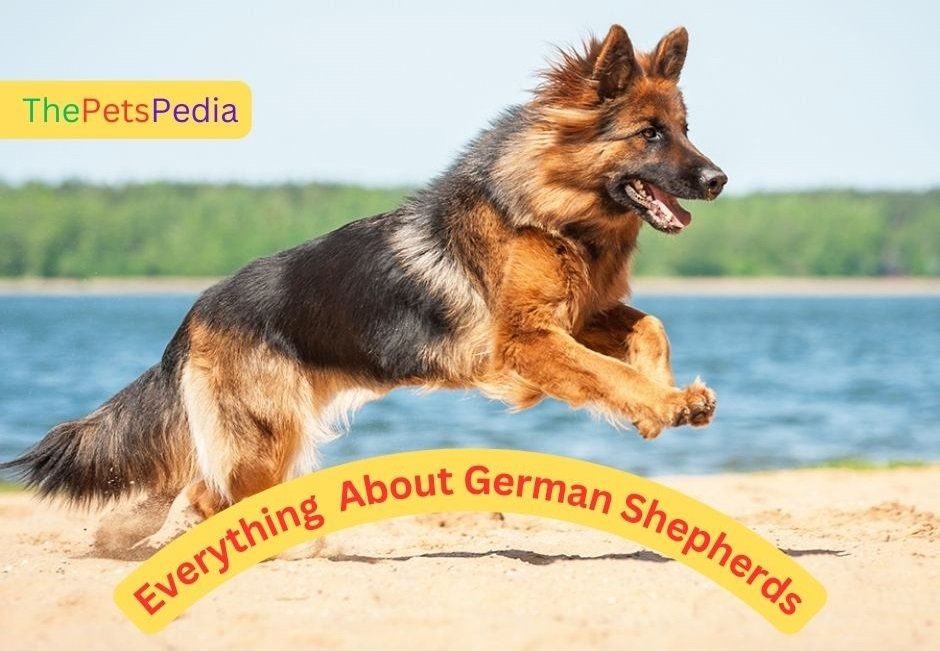German Shepherds are among the world’s most popular and respected dog breeds. Whether you’re considering adding one to your family or want to learn more about this remarkable breed, this guide covers everything you need to know. We’ve covered you from their rich history to their distinctive characteristics, temperament, care needs, and health considerations.
The German Shepherd: A Legacy of Loyalty and Bravery
- Origins and Early Development
The German Shepherd, or “Deutscher Schäferhund” in German, was developed in the late 19th century by Captain Max von Stephanitz, who sought to create the perfect working dog. By selectively breeding various sheepdogs from different regions in Germany, he aimed to combine intelligence, strength, and versatility into a single breed. The result was the German Shepherd, a dog quickly known for its exceptional herding, guarding, and service abilities.
German Shepherds gained worldwide recognition during World War I when they served as messengers, rescuers, and guard dogs. Their bravery and intelligence left a lasting impression, leading to their popularity across Europe and the United States. Today, they are beloved family pets and excel in roles such as police work, search and rescue, and even acting in movies.
- Evolution into a Versatile Working Dog
After the war, the breed’s potential as a working dog was fully recognised. In the United States, German Shepherds became famous for their roles in law enforcement and the military, where their keen senses and trainability made them invaluable. The American Kennel Club (AKC) officially recognised the breed in 1908, further cementing its status as a distinguished and versatile dog breed.
Physical Characteristics of the German Shepherd
Size and Build
German Shepherds are medium to large-sized dogs with a well-muscled, athletic build. They have a distinctive, noble appearance with erect ears and bushy tails. Their bodies are slightly longer than tall, giving them a powerful yet graceful stride.
| Size | Height | Weight | Characteristics |
| Males | 24 to 26 inches | 65 to 90 pounds | Large, muscular, and agile with a strong work ethic. |
| Females | 22 to 24 inches | 50 to 70 pounds | Slightly smaller and lighter but equally strong and active. |
Coat and Color
German Shepherds have a double coat consisting of a dense, harsh outer coat and a softer undercoat. This helps them withstand various weather conditions. Their coat colors can vary, including:
- Black and Tan: The most common color combination.
- Black and Red: A darker variation that is also popular.
- Solid Black: A striking and less common coat color.
- Sable: A unique coloration where individual hairs are banded with multiple colors.
Eyes and Expression
This dog breed has dark-colored, almond-shaped, medium-sized eyes. Their eyes convey a sense of intelligence, alertness, and curiosity, reflecting their attentive and watchful nature.
Movement and Gait
One of the breed’s most distinctive features is its effortless and powerful gait. German Shepherds move with a smooth, flowing trot to cover ground quickly and efficiently. This agility is one reason they excel in tasks requiring endurance and speed.
Temperament and Personality Traits
Intelligence and Trainability
German Shepherds are widely regarded as one of the most intelligent dog breeds. Ranked as the third brightest dog breed regarding working intelligence, they can learn new commands quickly and excel in various training exercises. They are often used in roles that require quick decision-making and problem-solving, such as police work and search and rescue missions.
“German Shepherds are the epitome of versatility in the dog world. Their intelligence and trainability make them suitable for any role.” — Dog Training Expert.
Loyalty and Protective Nature
German Shepherds are fiercely loyal to their families and often form strong bonds with their owners. They are naturally protective and make excellent guard dogs. Their alertness and courage mean they are constantly vigilant, ensuring the safety of their loved ones. This protective instinct is balanced with a calm and gentle demeanour, making them excellent companions for families with children.
Socialization and Interaction with Other Pets
Proper socialization from a young age is crucial for G. Shepherds to develop into well-rounded dogs. They can be wary of strangers and other animals if not adequately socialised. However, with the right training and exposure, they can coexist harmoniously with other pets and become friendly and outgoing community members.
Living Conditions and Space Requirements
Ideal Environment
German Shepherds thrive in environments with enough space to move and play. While they can adapt to various living conditions, including apartments, they do best in homes with a yard where they can exercise freely. Regular mental and physical stimulation is essential to prevent boredom and destructive behaviour.
Exercise Needs
This breed has high energy levels and requires at least one to two hours of exercise daily. Activities such as walking, jogging, agility training, and playing fetch are ideal for keeping them physically and mentally fit. They may become restless without adequate exercise and develop unwanted behaviours such as excessive barking or chewing.
Training and Exercise Requirements
Training Approach
German Shepherds are highly trainable and respond well to positive reinforcement techniques, including treats, praise, and play. Consistency and patience are key when training this breed. Early socialization and obedience training ensure they grow into well-behaved and confident dogs.
Exercise and Mental Stimulation
To stay happy, these dogs need physical exercise and mental challenges. Puzzle toys, obedience training, and agility courses are excellent ways to engage their minds. Regular playtime and activities like frisbee or ball games help channel their energy positively.
Health and Lifespan
Common Health Issues
Like all breeds, German Shepherds are prone to specific health conditions. Awareness of these issues can help you proactively keep your dog healthy.
- Hip and Elbow Dysplasia is a genetic condition that affects the joints, leading to arthritis and pain. Regular vet check-ups and maintaining a healthy weight can help manage this condition.
- Degenerative Myelopathy: A progressive disease of the spinal cord that can lead to paralysis. Early detection and supportive care are crucial.
- Bloat (Gastric Dilatation-Volvulus): A life-threatening condition where the stomach twists. Immediate veterinary attention is required if symptoms appear.
- Epilepsy: Seizure disorders can occur in some dogs. With proper treatment, most dogs can lead everyday lives.
Lifespan and General Care
German Shepherds typically live between 9 to 13 years. Maintaining a balanced diet, providing regular exercise, and scheduling routine vet visits are key to their longevity. Dental care is also essential, as poor oral hygiene can lead to health problems.
Care Tips
- Diet: Feed a high-quality dog food appropriate for their age, size, and activity level. Avoid overfeeding to prevent obesity.
- Grooming: Regular brushing (2-3 times a week) helps manage shedding and keeps the coat healthy. Bathe them as needed and keep their nails trimmed.
- Health Checks: Schedule regular vet visits for vaccinations, check-ups, and screenings for common breed-specific health issues.
Compatibility with Families and Other Pets
Interaction with Children
German Shepherds are generally good with children and can be gentle and protective. However, supervision is recommended around young children to prevent accidental rough play. Teaching the dog and the children how to interact respectfully is essential for a harmonious relationship.
Coexisting with Other Pets
With proper socialization, German Shepherds can get along well with other dogs and cats. Introducing them to other pets slowly and under controlled conditions will help ensure a smooth transition.
Adoption vs. Purchase: Making the Right Choice
Adoption Benefits
Adopting a German Shepherd from a shelter or rescue organization can be a rewarding experience. Many beautiful dogs are looking for loving homes. Adoption helps reduce the number of homeless pets and supports animal welfare organizations.
Choosing a Reputable Breeder
Finding a reputable breeder is crucial if you purchase a German Shepherd. Look for breeders who perform health screenings and are transparent about their dogs’ health histories. Avoid buying from puppy mills or irresponsible breeders, as these sources often prioritize profit over the dogs’ well-being.
Conclusion
German Shepherds are exceptional dogs, known for their intelligence, loyalty, and versatility. Whether serving as a working dog, family companion, or loyal friend, they bring a unique blend of strength and sensitivity to any role they take on. While they require a significant commitment in training, exercise, and care, the rewards of owning a German Shepherd are immeasurable.
By understanding their needs and providing a loving and stimulating environment, you can ensure your German Shepherd leads a happy and healthy life. Whether you adopt or purchase, making an informed decision will help you build a lifelong bond with this incredible breed.



